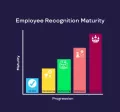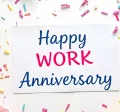
Crafting a Letter of Recognition: How to Acknowledge Exceptional Contributions
March 4, 2024
Words are powerful, and a well-crafted letter of recognition thanking an employee for their contributions can be a game-changer.
Whether you’re penning a short note to make sure employees feel appreciated in the day-to-day, or writing a more formal letter as part of a broader employee awards and recognition program, expressing gratitude in written form is well worth the effort.
Recognizing a direct report or a colleague is a proven way to increase happiness in the workplace, boosting employee morale and retention. In fact, a recent study found that 82% of employees say recognition plays an important role in their overall job satisfaction. And 80% say that being recognized motivates them to do their best work.
So, how do you write a letter of recognition that makes a difference? Read on for letter of recognition examples, work recognition messages and employee recognition best practices.
Understanding the Significance of Letters of Recognition
Employee recognition is a critical aspect of fostering a positive work environment and maintaining high morale within an organization. Acknowledging exceptional efforts through formal letters of recognition is a tangible way to demonstrate appreciation and gratitude to employees who go above and beyond in their roles.
A letter of recognition for outstanding performance serves many purposes, including:
- Reinforcing the value of hard work and dedication
- Encouraging continued best efforts
- Setting a positive example for other team members
- Differentiating between routine tasks and extraordinary contributions
- And, of course, rewarding employees for their great work
While all employees are expected to fulfill their essential responsibilities – it’s part of the job, after all – those who consistently go above and beyond deserve special acknowledgment.
Identifying Exceptional Contributions in Your Letter
When crafting your letter of recognition, make sure to clearly identify the exceptional contributions your employee delivered.
This could include a variety of actions and behaviors, such as:
- Demonstrating exceptional leadership or teamwork skills
- Going above and beyond to meet or exceed goals
- Showing innovation and creativity in problem-solving
- Making significant contributions to the organization's success
- Providing exceptional customer service or support
Examples of exceptional contributions can vary depending on the context. In terms of work, it might include taking on additional responsibilities, leading a successful project or consistently exceeding performance targets. In the workplace community, it might include volunteering to support a colleague, mentoring a peer or sharing knowledge in a lunch-and-learn session.
It's also important to recognize both tangible and intangible efforts. Tangible contributions, like a measurable increase in sales or cost savings can be easier to quantify, but intangible contributions like helping foster a positive work culture are equally valuable and deserving of recognition.
Structuring the Letter
While it’s the words that matter most, the right structure is important for ensuring that it effectively conveys those feelings of appreciation and gratitude. The letter should be well-organized with a clear introduction, body and conclusion.
→ Introduction: Establish the purpose of the letter and provide context for the employee's contributions. Include an opening sentence that expresses genuine appreciation and gratitude for the employee's efforts.
→ Body: provide specific details of the employee's contributions, including examples of their exceptional work and the impact it has had on the team or organization. Highlight the personal qualities demonstrated by the employee, such as dedication, innovation or leadership.
→ Conclusion: Reinforce the appreciation and gratitude you expressed in the opening. If suitable, share positive expectations for future contributions and encourage the employee to continue their exceptional work.
Writing Tips and Guidelines
The more letters of gratitude you write, the more you will develop your own style. In general, though, the following tips and guidelines can help:
- Be clear and specific in your language, avoiding vague or generic statements
- Use descriptive language and examples to convey sincerity and appreciation
- Tailor the tone of the letter to match the recipient and the context
- Avoid rambling and unnecessary details, keeping the letter to the point
Dos:
- Be genuine and sincere in your appreciation
- Be specific about the employee's contributions and the impact they had
- Be timely in your recognition, acknowledging the employee's efforts as soon as possible.
Don'ts:
- Be vague or generic in your language, as this can dilute the impact of the recognition
- Be insincere or overly formal, as this can come across as disingenuous
- Be critical or negative, as this can undermine the purpose of the recognition
Sample Templates and Phrases
For those who may be unsure of how to begin or what specifically to include in a letter of recognition, sample appreciation templates and phrases can be helpful as a starting point. But make sure to tweak and personalize these example phrases to avoid coming off as disingenuous or insincere.
Phrases to express gratitude and admiration can include:
- "I would like to express my sincere appreciation for your exceptional contributions to our team."
- "Your hard work and dedication have not gone unnoticed and I am grateful for your efforts."
- "Your contributions have had a significant impact on our team and organization, and I want to thank you for your exceptional work."
- "I want to take this opportunity to thank you for your ongoing dedication and hard work. Your positive attitude, professionalism and willingness to go above and beyond have not gone unnoticed. I am grateful to have you as a valuable member of our team."
- "Your remarkable efforts have not only made a difference in our team's success but have also helped create a positive and motivating work environment. Thank you for all that you do!”
- "Your willingness to take on challenges and your drive to succeed have been an inspiration to us all. Thank you for your exceptional work."
Incorporating personal anecdotes or specific achievements adds a more personal touch to the letter and can make it more meaningful.
Delivering and Following Up
Consider the best delivery method for your letter. An email or digital message sent through a recognition platform can be a great way to ensure that the recognition is received promptly and can be easily shared and preserved.
A physical letter may be a better fit for formal recognition or to accompany a physical gift.
Either way, following up is important as it allows you to gauge the effectiveness of the recognition and to ensure that the employee continues to feel appreciated and valued.
Tying It All Together
Letters of recognition are a powerful tool in a toolbox of employee engagement strategies for cultivating a positive work environment that fosters great work and happy employees.
By clearly defining what constitutes exceptional contributions, structuring the letter effectively and following some fundamental writing guidelines, you can create a meaningful and impactful letter of recognition that leaves a lasting impression. So, go ahead and start recognizing your employees for their exceptional contributions with written messages – you'll be amazed at the positive impact it can have on your organization!





